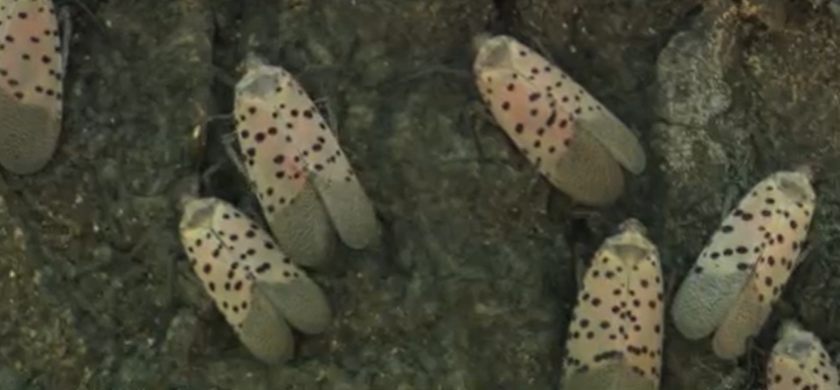Spotted lanternflies are wreaking havoc on Maryland vineyards and ecosystem
You've probably seen spotted lanternflies all around Maryland and Baltimore. They are tan and covered in black spots.
When they open their wings, a bright red flashes in front of you.
Spotted lanternflies are an invasive species in Maryland, and although they will not harm you, they are threatening our ecosystem and farms.
What are they and how did they get here?
Experts believe the spotted lanternfly came over from China on a stone shipment to Berks County, Pennsylvania, in 2014. They then entered Maryland in 2018.
Megan Carr, a Forest Ecologist with Baltimore City Recreation and Parks' Forestry Division, said they were first found in Baltimore in 2021.
They are an invasive hopper insect that suck sap from grapevines and trees, including the weeping willow, maples, and black walnuts.
Jessica Boyles, an Environmental specialist and coordinator for the spotted lanternfly program at the Maryland Department of Agriculture, said you've probably seen what the adult looks like.
"Usually you see the pictures with the splayed wings, where you see the red underneath, and they've got those black dots on the forewings with the brown," Boyles said. "That's pretty typical. We also have fourth instars, which are right before adults. The fourth instars are rather small; people mistake them for spiders most of the time because they're so low. They're red and black and white." The youngest ones are just black and white.
The insect will lay their eggs in the fall. The egg masses have been described as grey-white and look like mud or clay on a tree. Those eggs will hatch in April or June.
Where do you see them?
In short, everywhere.
Their preferred tree host is the Tree of Heaven, which is invasive itself. It first came over as a landscaping tree because it provides good shade and beautiful flowers.
Boyles said the Maryland Department of Agriculture does a lot of management for vineyards and high-transportation pathways.
The Tree of Heaven grows in disturbed environments, like where roads and trains are built.
"We get a lot of reports of people going to Marc stations and seeing a ton of Spotted Lanternfly," Boyles said.
How are they harmful?
"The good news to people is that it's not harmful to humans, but it definitely has some impacts on our local ecosystems," Carr said.
But she also said they rarely kill trees, and our forests aren't losing canopy from them.
They hop around a lot and can be startling, but they do not bite or sting. However, they can attract others who do.
"My biggest concern about spotted lanternflies in a home landscape is that the honeydew will attract vast numbers of stinging insects," said Michael Raupp, a former professor of entomology at the University of Maryland. "Yellow jackets, paper wasps, hornets, honeybees, this poses a risk to humans and pets in those landscapes."
Boyles said it's the secondary issues that can harm the trees. Since the bugs eat sap, they are creating wounds in the trees, which can open them to other pests and diseases.
Spotted lanternflies also excrete honeydew, which is just sugar and water. However, when it sits on vegetation, it creates sooty mold. "And that sooty mold stops photosynthesis," Boyles said. "Or it decreases the ability for that plant to photosynthesize."
The sooty mold can also get on your outdoor furniture and cars and cause a mess that's hard to get rid of.
"The No. 1 complaint I get is that it reduced people's quality of life, " Boyles said. "Because they feel like they can't enjoy their backyard."
Boyles doesn't have an answer on how to clean it up.
"I've heard some people say that if they took regular cleaning products to their grills and porches, they are able to get it up; sometimes it stains, but they are able to get it up. It's not a good solution," Boyles said.
The bugs can also deter people from getting outside and enjoying nature and the city's forests.
"For us, our main issue is that they're really just kind of gross," Carr said. "You see all these bugs moving around, some people are afraid of them. And sometimes you'll have the honeydew actually raining down on you. And those can be issues."
Impact on vineyards
All the experts that WJZ spoke to about the spotted lanternfly seem to agree that one of the biggest threats of the insect is to vineyards and grapes.
"When spotted lanternflies are able to feed on them, they reduce their ability to overwinter, deplete nitrogen, and they can reduce the ability for the vines to grow profitable grapes the following year, sometimes they're really sickly," Boyles said. "They can stunt the growth of young vines, so it's an awful, awful sentence for vineyards."
Edward Boyce and his wife planted the first grapes at Black Ankle Vineyards in Mount Airy in 2003.
Farming can always come with unforeseen challenges, but Ed says on average, they are probably down about 60% in their harvest so far this year. And the bugs are a big part of it.
"We've been through multi-colored Asian Lady Beetles, been through stink bugs, been through a couple other invasive insect pests," Boyce said. "Eventually, you deal with them. That's farming. This is the worst. By far."
Boyce said the invasive bugs tend to go to the edges of his field. That's because they aren't the best flyers, but tend to hop to nearby plants.
"The middle is down maybe 40-50% but the edges are literally nothing," Boyce said about his grape production this year.
And nature is not helping much.
Boyce has seen some yellow jackets attack them, but not much else.
"The only thing I've actually seen eat them is my cat. Who just whacked one out of the air. Who looked at it and gobbled it right up," Boyce said. "But there's a few too many for my cat to eat them all."
To try to mitigate the problem, Black Ankle Vineyards knocked down the Tree of Heaven they had around their property. They also work with the Maryland Department of Agriculture.
And, they scrape off egg masses when they see them.
But when the bugs start killing the vines, they have to start spraying insecticide, which he does not like to do.
"That's really frustrating because we worked so hard to build a good balance in the vineyard between the good, bad, and the bad bugs," Boyce said. "And the good bugs keep the bad bugs in balance and to a dull roar, and everyone's happy. Then something like this happens, and it throws the whole balance off. And it's a lot of work and a long time to get it back."
Boyce said they usually harvest about 200 tons of grapes, but he thinks it will only be about a hundred or so this year. He believes it's mostly due to the bugs.
Eventually, he said it will impact their profits.
"We have wine down here stored from the last couple of years. This just means we will have less in the future, and we are gonna run out, and I don't know what we're going to do from there," Boyce said. "But that's tomorrow's problem. Today is just how much we can save with what we have."
For the wine-loving consumer, Ed said his prices will not go up because of the competition.
"It's a very local phenomenon," Boyce said. "If there were a market for Maryland wine, then yeah, prices would go up. But we are competing with wine from France, California, Washington state, Chile, and wherever else. And they don't have this problem."
But looking at the bright side, the wine they do harvest could taste better.
"We may only have last or less of our normal harvest, but if we keep getting decent weather the next few weeks, we may make some really good wine, and that might compensate a little bit for it, with really good quality," Boyce said.
Boyce remains optimistic.
"If I've been good about keeping on these things, then yes, next year's looking better," he said. "Just know we are all trying to deal with it the best we can. And help us by buying local."
Fixing Maryland's spotted lanternfly problem
The Maryland Department of Agriculture has its own program to tackle the problem of Spotted Lanternflies. They work with other organizations to help provide treatment and reduce spread, and that does include insecticides, but that's not all.
"We also conduct mechanical treatments, so without the use of chemicals," said Boyles, who runs the Spotted Lanternfly Team at the Department of Agriculture. Her team uses backpack vacuums.
They also do a lot of research on treatments to give to the U.S. Department of Agriculture (USDA). Although, because of federal spending cuts, the Spotted Lanternfly team was cut in half. But sitting on the department's property in Annapolis, you can see the research in progress. A few weeks after conducting a systemic treatment on a tree, you could see it was already working, as lanternflies littered the ground. However, the systemic treatment lives inside the tree and the department is very strict about using it.
"We are very specific on when we do it, how we do it, and on what trees we do it on," said Boyles. "It's a really harsh chemical product that Maryland citizens cannot purchase."
So while research is being done to combat the problem, what can the average Marylander do in the meantime? They may be pretty, but if you see them, kill them. However, stomping on them will not entirely solve the problem, according to Michael Raupp, a former professor of entomology and self-proclaimed 'bug guy.'
"If it makes you feel better, retribution, well, sure. Go ahead and squash as many as you'd like if you'd like to," Raupp said, "But please understand that that's not what drives the rise and fall of spotted lanternfly populations."
It will help if residents get rid of any Tree of Heaven on their property, as it's the bugs' preferred host and is invasive itself. They can also scrape off any egg masses on trees or posts. The egg masses look like a little dab of clay and are whitish grey. No expensive tools are needed.
"A lot of time I will go with a little putty knife, or even something like old credit cards," Carr, a forester with the Baltimore Parks and Recreation Department, said. "If you can scrape that egg mass away, then that's actually taking care of 30-40 spotted lanternflies for next year."
Residents can also make their own traps. Boyles and Carr both said they do not prefer sticky tape traps because other animals can get trapped in them, including small birds. They suggest making a circle trap, which do not harm other animals, are successful in trapping the Spotted Lanternflies, and are cheap. All you need is mesh, paint sticks, the tops of some milk cartons, a zip-lock bag, and something to tie it to the tree. Carr said she could make three or four traps with just $8.
"As the lanternflies crawl up and down the tree trunk, you know, they're not the smartest insect," Carr said, "So they will start making their way up. And the screening funnels them into your milk jug lids, and then into a zip lock baggy, or you can use a jar, basically anything you can fit over the top that you can collect them when they come in."
Carr suggests following the instructions on how to build circle traps from the Penn State Extension website.
Report Spotted Lanternflies on the Maryland Department of Agriculture's Website here.
While the department hopes to help reduce the number over the next few years, it is unlikely the species will be eradicated completely.

